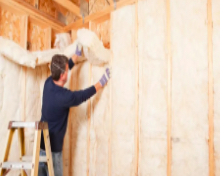Blow In Insulation Perth is preferred to add insulation to an existing closed-up wall or attic. The process is quick, convenient, and less invasive than other methods. Professional installers use a specialized blower to distribute the loose-fill cellulose insulation in your attic. They can locate wall cavities and work around existing electrical junction boxes.
Blow-in insulation costs vary depending on the type and thickness you choose. You can save money by doing the job yourself, but this project could be more efficient and easier for most people. It’s best to hire a professional, especially if you’re using cellulose.
The average price of blown-in insulation is around $500 to $2,000 for a home, depending on the size. The amount you save on energy bills will add up to more than the initial cost of insulating your house.
Adding insulation to your exterior walls is one of the most cost-effective ways to reduce your home’s energy costs. This is because thermal transfer through these areas is a major source of heat loss. Insulating this area also helps prevent condensation in the walls, which can lead to moisture damage.
In addition, blown-in insulation can help you save on your heating and cooling bills by keeping the air inside your house more consistent. This helps to prevent drafts and humidity, which can contribute to the high cost of air conditioning.
Another benefit of blown-in insulation is that it provides some noise-canceling effects. This can be beneficial if you live near a highway or airport or have noisy neighbors. It can also reduce room-to-room noises.
It’s important to note that different types of blown-in insulation have differing R-values. The higher the R-value, the more energy your home will save. The Department of Energy has a R-value chart that you can use to determine the right level of insulation for your house.
The most affordable type of blown-in insulation is fiberglass. It’s made from spun threads of glass, and it can be found in the form of batting or loose fill. It can be used in various applications and is usually the best choice for new construction projects.
If you’re looking for a greener option, mineral wool insulation is an excellent alternative to fiberglass. It’s made from recycled materials like blast furnace slag and fine-grain rock. It’s often combined with a liquid to create a spray that can be blown into wall cavities.
While the initial cost of blown-in insulation can be expensive, it is an investment that can pay for itself over time with energy savings. It can also increase the value of your home and make it more comfortable. In addition, it may help reduce your home’s carbon footprint, depending on how you heat and cool your house.
Blow-in insulation is made from recycled materials and provides a high R-value, which helps to limit heat flow in and out of a home. It also provides a tight seal, which can be especially useful for older homes where gaps and crevices in walls are common.
The material is blown into wall cavities by using a machine. This allows it to fill all the nooks and crannies of a wall, which increases its thermal efficiency. This method is superior to traditional fiberglass batt insulation, often leaving air pockets that weaken its performance.
Cellulose blown-in insulation is commonly used in new construction and remodels because it can be installed without disturbing existing building materials. It’s eco-friendly and offers a higher R-value than fiberglass batt insulation. It also helps reduce mold and moisture. Fiberglass blown-in insulation is also available, but cellulose could be better for most applications.
Both cellulose and fiberglass insulation are effective in limiting the transfer of heat through conduction, convection, and radiation. They can be used to insulate a home or commercial space’s walls, floors, and attics. They can be purchased at many home improvement stores, but installation requires a specialized blower machine.
Adding blown-in insulation can be a DIY project for some homeowners. Still, it is important to hire a professional to ensure proper installation and prevent damage to the home’s structure. It is also important to understand that if the insulation is damaged or not installed correctly, it could lose effectiveness over time.
Blow-in insulation can last up to a lifetime when it is properly installed and maintained. It is made from recycled paper products and other materials, which keeps waste out of landfills. Depending on how you heat and power your home, it can also reduce your carbon footprint.
When properly installed and maintained, blown-in insulation can dramatically improve your home’s energy efficiency. However, several factors can impact the effectiveness of your insulation. These include air leaks, ice dams, water infiltration, and drywall and attic damage. These issues can cause the energy savings that you have worked so hard for to be diminished. Fortunately, these problems can be easily avoided with a little planning and preparation before installing insulation.
It’s best to hire professionals to install blown-in insulation. They will know how to seal air leaks and use the right type of insulation for your home. They will also ensure that all pipes, wires, and electrical boxes are insulated before the blown-in insulation is put in place. It’s important to do this as it will prevent leaking air from entering the insulated area.
Blown-in insulation can be messy during the installation process. The loose cellulose fibers blown into walls and attics can leave a mess behind. This can be difficult for homeowners to clean up. It can also aggravate allergies for individuals sensitive to newspaper ink or chemical fire retardants.
It is also possible for blown-in insulation to grow mold or mildew in a home if it becomes wet. This is because the cellulose insulation is made from paper products and absorbs moisture. If there is a roof leak, pipe leak, or high humidity, the insulating materials can become wet and take a long time to dry out. The damp cellulose can then become an incubator for mold and mildew.
In addition to mold and mildew, blown-in insulation can be prone to rot and other issues if not properly installed and maintained. If you notice that your blown-in insulation is showing signs of deterioration or has a hole, contact Ideal Insulation to have it replaced.
Insulation is a key part of a healthy building and can help reduce energy consumption. However, not all insulation materials are created equal. Some are kinder to the environment than others. Choosing environmentally friendly insulation can reduce your home’s environmental footprint and contribute to the preservation of natural heating resources. Blow-in cellulose insulation is one of the most environmentally friendly insulation options available.
Cellulose insulation is made from recycled newspaper and cardboard boxes, which are shredded and pulverized before being mixed with fire-retardant chemicals. This material is then blown into attics and walls with special machines using pneumatic pressure. This insulation creates very little waste during installation, and the leftover cellulose can be used on future projects, which reduces garbage sent to landfill sites. This insulation also contains no harmful products like formaldehyde, fiberglass, or ammonium sulfate.
Most other insulation materials require fossil fuels to be mined and manufactured, including foam plastics like polystyrene and polyisocyanurate. These fuels are depleting, and as they dwindle, they will become more expensive. By choosing a greener insulation option, you can save money on energy bills while reducing your environmental impact.
Although blow-in cellulose insulation is a greener choice than other types of insulation, it still requires a lot of energy to manufacture and install. This is due to its high recycled material content and its use of a blowing machine, which requires electricity or gas. This energy consumption hurts the environment, but it is offset by the fact that cellulose has a lower carbon footprint than other insulation materials.
Regardless of the type of insulation you choose, it is important to determine your needs before purchasing. A professional energy audit can provide the information you need to select an appropriate amount of insulation. This will ensure that your insulation is not too thick or too thin, which can cause damage to your walls and increase your energy costs.
While blown-in cellulose insulation is considered safe for most people, it can pose health risks to those allergic to ink fumes and newsprint. In addition, some chemicals applied to cellulose can corrode wires and pipes, creating additional safety concerns. Fortunately, these risks can be minimized by following proper installation and handling procedures.

